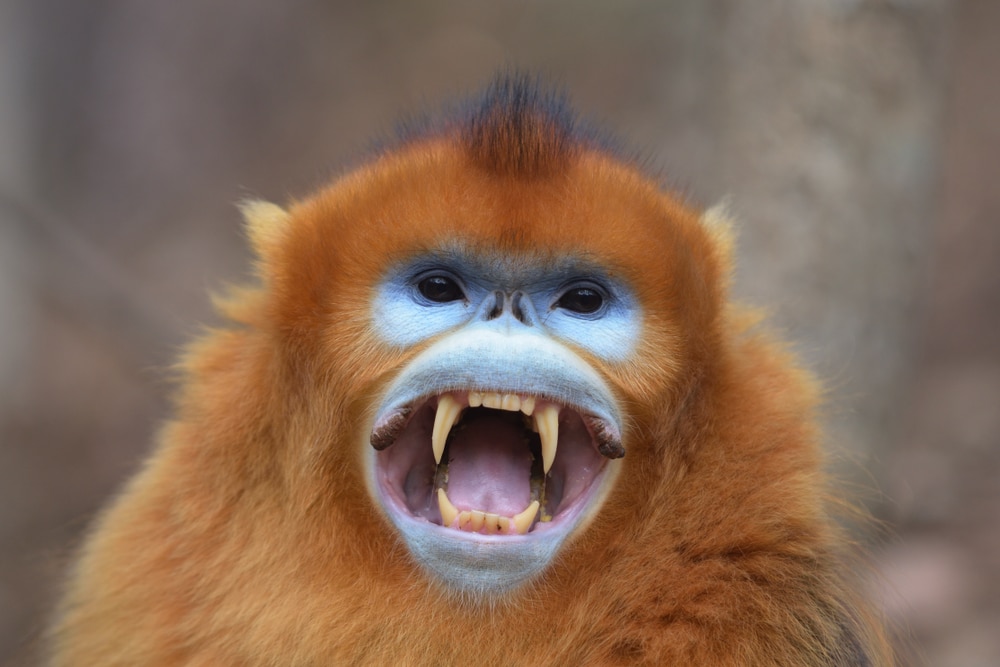What if your nose could protect you against frostbite? Golden snub-nosed monkeys have large nostril flaps. These cover the nostrils and likely protect the golden snub-nosed monkey from frostbite.
This is a handy trait to have since they live in montane forests. Their habitat becomes downright frigid over the winter months.
The golden snub-nosed monkey is an endangered species. They’re endemic to the southeastern parts of China. Do you want to find out more about what makes these primates unique? Keep reading.
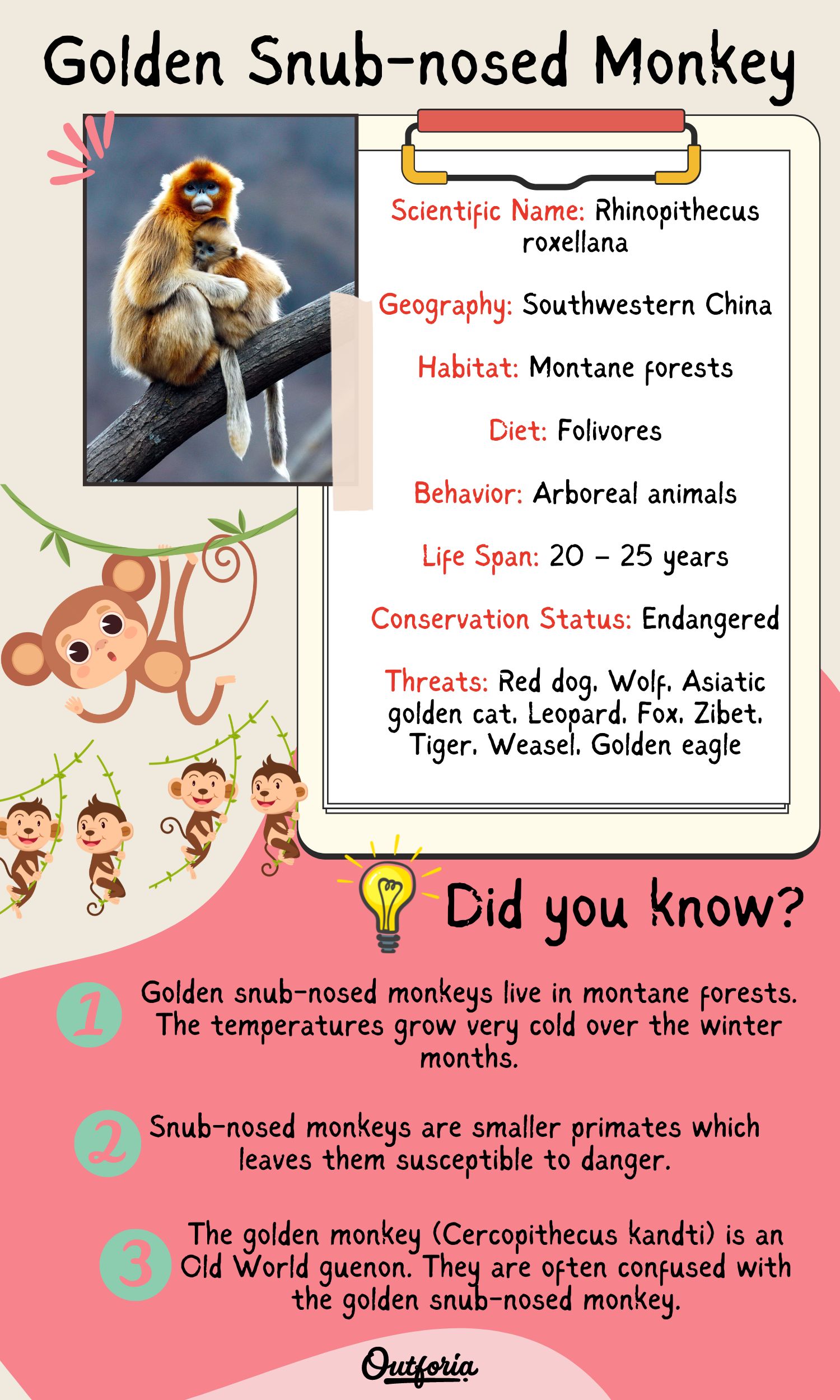
Share This Image On Your Site
You May Also Like: Wild Monkeys In Florida: All About Them And How They Got There
Classification
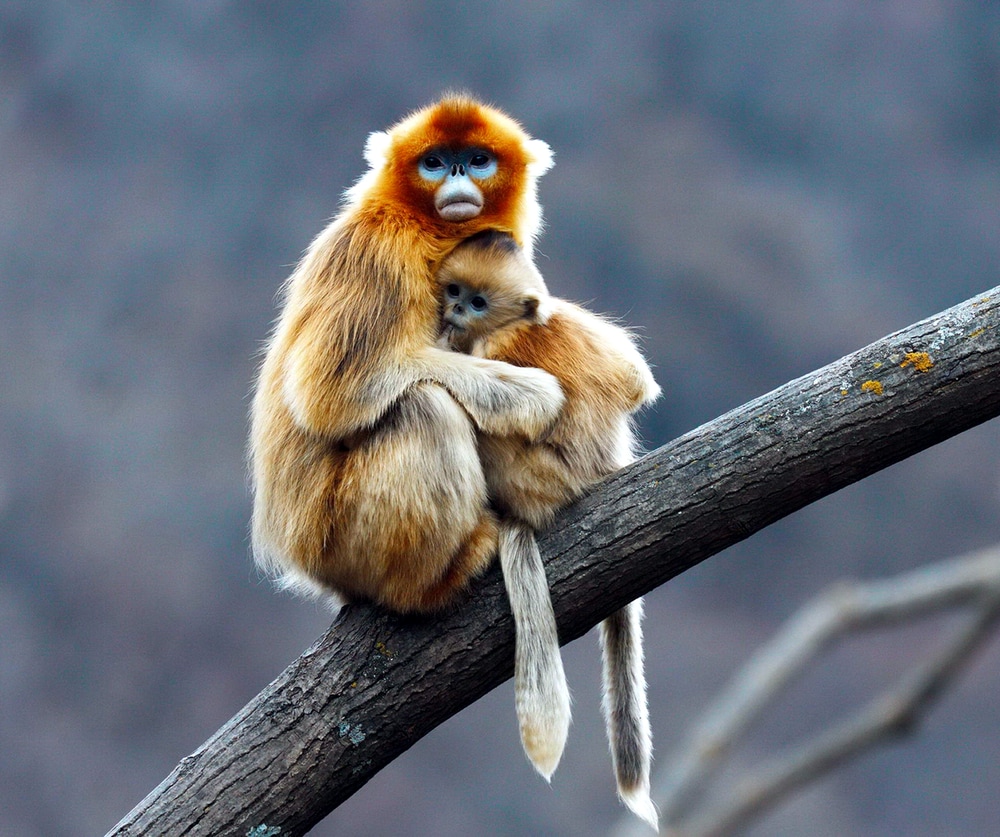
The golden snub-nosed monkey (Rhinopithecus roxellana) is sometimes called the Sichuan snub-nosed monkey.
The French naturalist Henri Milne-Edwards chose the name of the golden snub-nosed monkey. He named them after the mistress of Suleiman the Magnificent.
Suleiman the Magnificent was a 16th-century sultan of the Ottoman Empire. They got this name because they resembled the mistress. Historians describe her as having a snubbed nose and goldish-red hair.
There are two other subspecies of the golden snub-nosed monkey that inhabit China. These subspecies are R. r. Hueinsis and R. r. qinlingensis.
There may also be a fourth subspecies located somewhere in India. But, this is still debated in the scientific community due to a lack of evidence.
The subspecies vary in physical characteristics, which allow us to identify them.
R. r. Qinlingensis’s golden fur is the most brightly golden-colored of all three subspecies. Males average a body length of 22.9in (58.2cm), and the females average 19.1in (48.4cm).
R. r. Hueinsis’s fur is golden in color, but it is a much paler hue than the other two subspecies. Males average a body length of 26.5in (67.4cm), and the females average 18.7in (47.5cm).
Characteristics
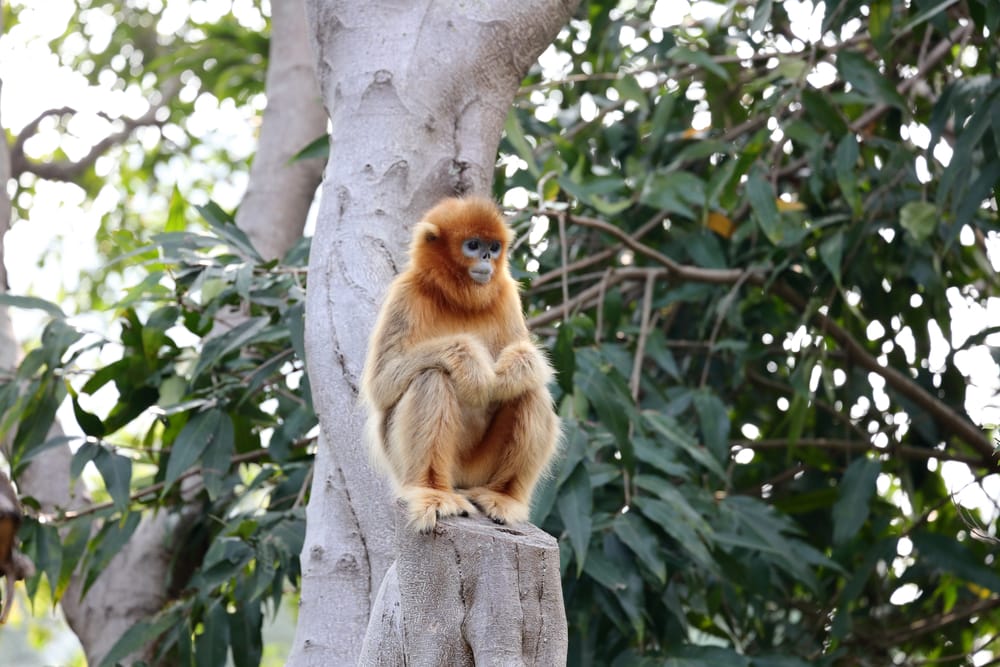
These monkeys stand out due to their flat nose, for which they get their name. The nose sits further back from the muzzle and their large nostrils face forward.
Researchers believe their stubby noses protect them from frostbite. They live in a very cold climate, where this is a real threat.
Aside from their noses, their facial features are quite remarkable. Their eyes have a rim of light blue overtop a white and hairless muzzle.
Because they live in such cold temperatures, they also have thick coats to keep them warm. The males have vibrant golden fur that is brightest on their head and neck. Long black guard hairs streak their shoulders, back, and upper arms.
Females have very similar coloration. The only difference lies in their guard hairs, which are dark brown rather than black.
Males are also more brightly colored than their female counterparts. In fact, as males age, their golden-colored fur becomes more vibrant.
Their fur is so striking because of the length of the hair. The fur on their body reaches lengths of about 2-3.1in (5-8cm). Longer, brighter hairs speckle their body and reach lengths of about 4.7-6.3in (12-16cm).
Back hair on the males can reach incredible lengths. It starts growing around six years of age as they become sexually mature. These gorgeous back hairs can reach lengths of up to 21.7in (55cm).
They have incredibly long tails. Their tails are generally about as long as the length of their head and torso.
The three subspecies have even longer tails. The subspecies have tails reaching up to 125% of the length of their head and torso.
Where Do Golden Snub-Nosed Monkeys Live?
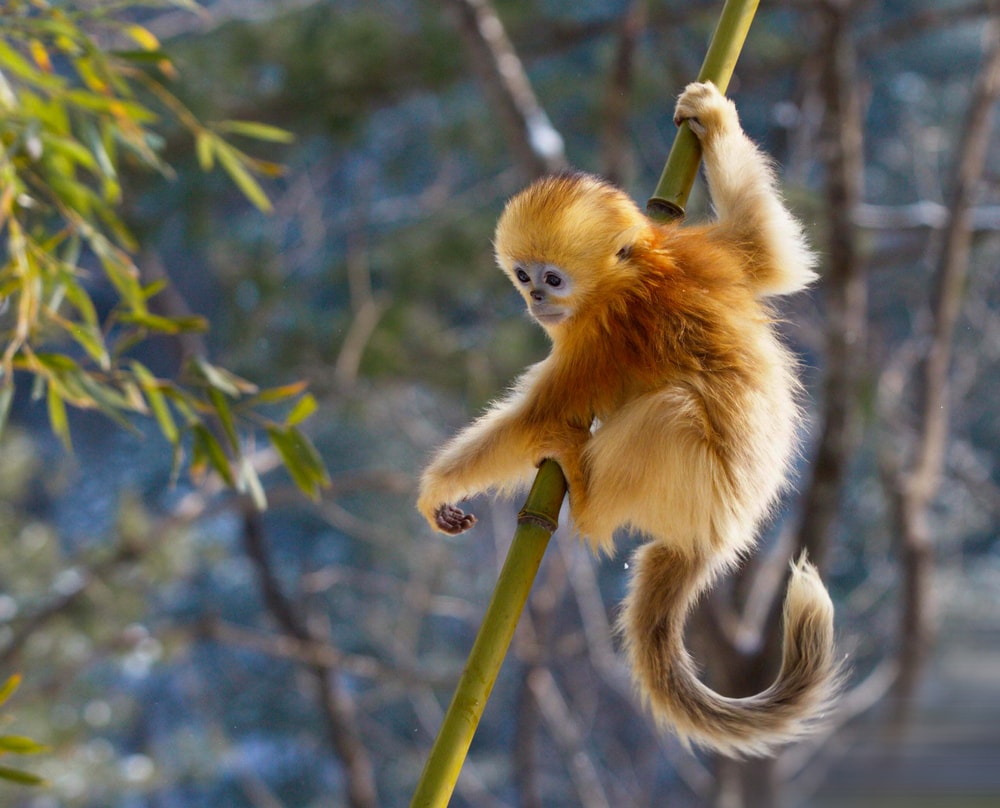
These primates are endemic to the Tibetan Plateau. This is a fragmented region found in southwestern China.
Most of these monkeys live in China’s Sichuan Province. The province resides inside the Woolong Natural Reserve. But, you can also find them in the Gansu, Hubei, and Shaanxi provinces.
R. r. Roxellana lives in the western parts of the Sichuan province. They also live in the southern region of the Gansu province. R. .r. Quinlingensis only lives in the southern Qinling mountains of the southern Shaanxi province. R. r. Hubeiensis lives in the Hubei province and the southeastern Sichuan province.
Habitat & Climate
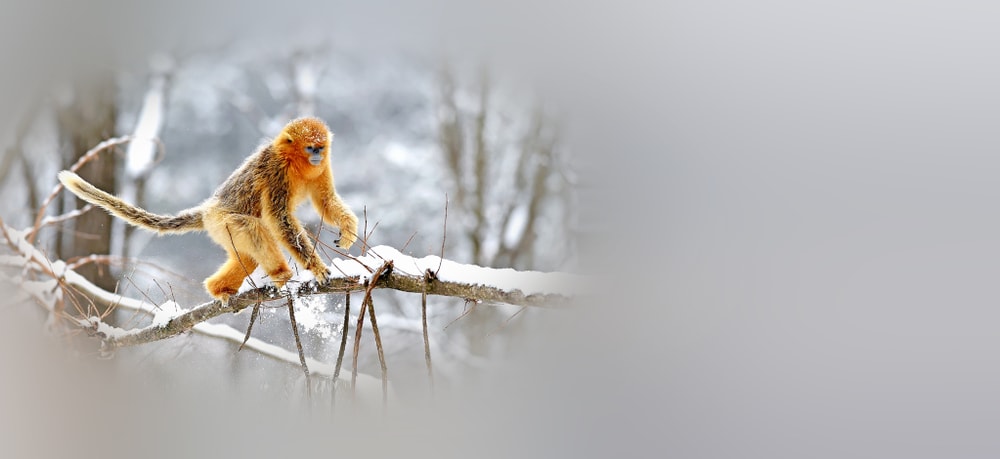
Golden snub-nosed monkeys live in montane forests. Montane forests have high elevations. They cover parts of the Borneo highlands from a height of 3,280-10,826ft (1,000-3,300m) above sea level.
Plant life common in these forests includes oaks, laurels, and rhododendrons. Moss covers the bushes, and the canopy drops lower the higher the elevation.
Montane forests are notorious for their harsh climates and lack of shelter and food. So, there isn’t much diversity in the wildlife compared to lowland rainforests.
Golden snub-nosed monkeys can withstand frigid temperatures. They live in montane forests where only a few other primate species live. Temperatures can drop as low as 17℉ to -8°C.
They thrive in a climate colder than any other area inhabited by non-human primates. For about four months every year, they live amongst snow that blankets the forest.
They love to live amongst forests of deciduous, broadleaved, and mixed-evergreen coniferous trees. If they aren’t available, you’ll find these areas in secondary forests or shrubland. They prefer the mountains for most of the year. But they may travel to the lowlands over winter when the temperatures are harshest.
You May Also Like: 39 Fascinating Amazon Rainforest Animals, Birds & Insects
What Do Golden Snub-Nosed Monkeys Eat?
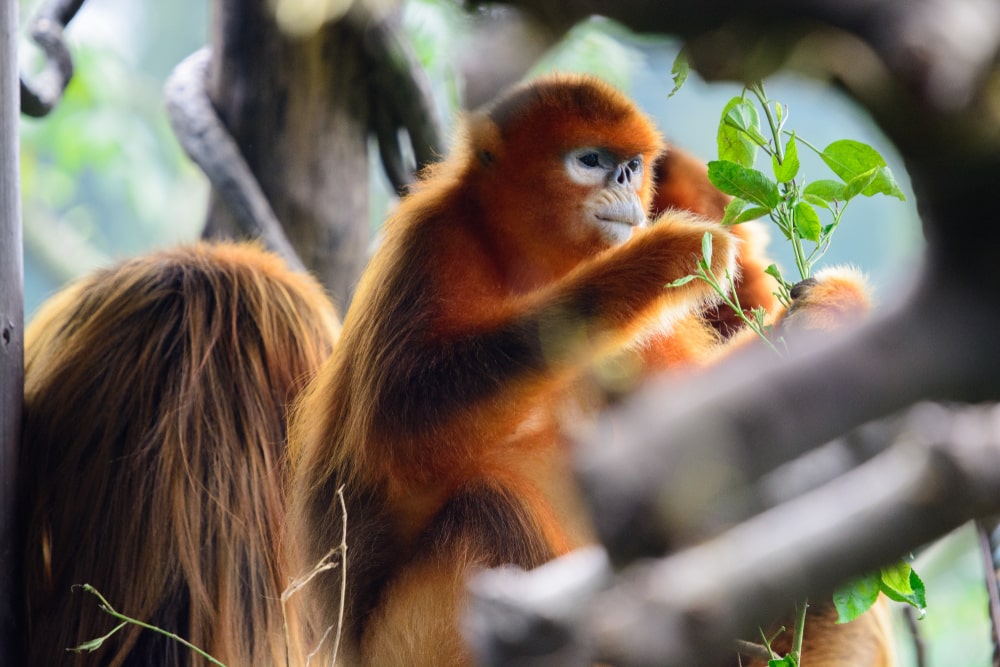
These monkeys are folivores and their diet changes based on the season.
April through November is when these monkeys feast on their regular diet. They are foragers who look through the middle and upper layers of the forest canopy. They will eat flowers, buds, leaves, and fruits.
During most of the year, lichens make up 43.28% of their diet. Young leaves make up 28.71%, fruits and seeds make up 14.57%, and buds make up 5.36%.
On the lower end, mature leaves make up 3.51% of the diet, herbs make up 2.09%, bark 1.36%, and flowers 1.13%.
As the winter months approach, they begin feasting on fatty seeds. These seeds help them build a layer of fat that gives them energy over winter.
In winter, most of their usual food hides under snow, so it’s hard for them to access right away. Rather than trying to dig through the snow, they eat lichens over the winter months. Sometimes, they’d choose to eat even the snow itself.
Behavior
Arboreal
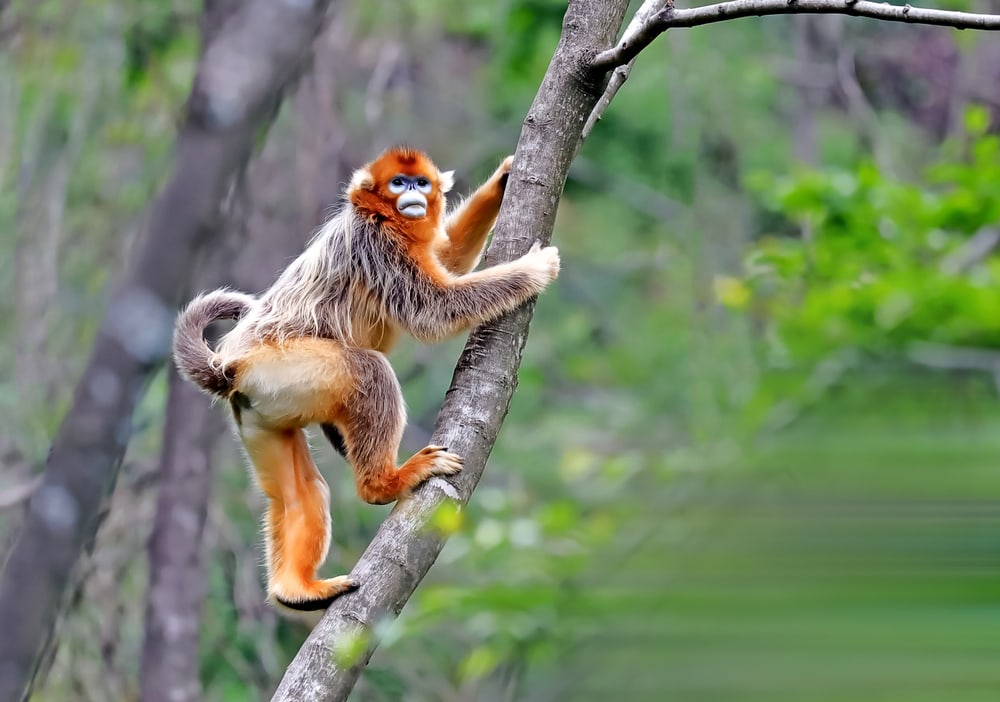
These monkeys are an arboreal species that spend upwards of 97% of their time in trees. They prefer staying in the middle to upper-level canopies where they feel safest. At night, the females and juveniles sleep together in groups to keep warm. The males sleep separately.
In captivity, they are more likely to frequent the ground. They have no predators in a captive situation. So, they’ll spend half their time on the ground and the other half in the trees.
Travel & Danger
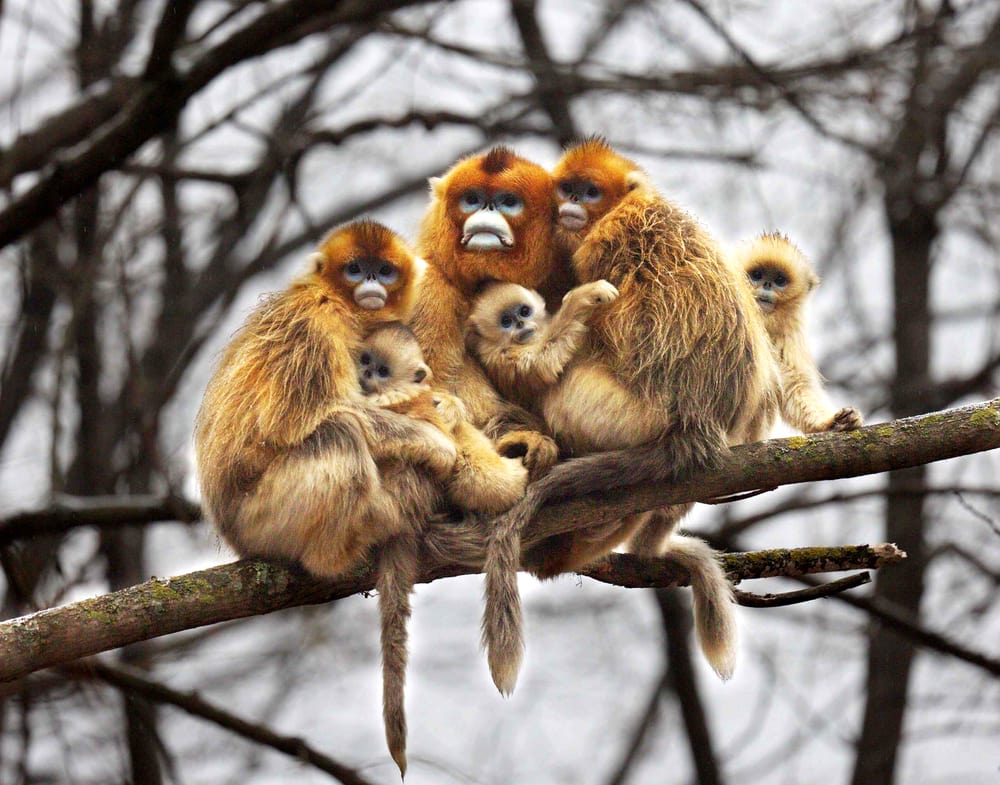
Golden snub-nosed monkeys break up their day based on the time. The groups will travel through the trees in the morning and afternoon, looking for food. On average, they travel a distance of 2,329.4-6,889.8ft (710-2,100m).
As the group leaders, the dominant males will take up positions at the front and back of the group. The females and their offspring will live at the center of the group.
If dangerous predators threaten them, the males will protect the vulnerable members. All the males will come together to scare off the danger. They threateningly move their limbs and vocalize. As they do that, the females and offspring will flee to the trees.
Occasionally, they may come to the ground as well. It’s more common to see males travel to the ground versus females and their offspring.
They will take a break around noon, eating in the trees, grooming, and socializing. In larger groups, the juveniles will band together in groups as large as 40 individuals. While the adults are eating, the juveniles will play.
Their home ranges are quite larger, often spanning about 7.1-15.4 sq. mi (18.3-40 sq. km). Because groups often come together, the home ranges of different groups may overlap.
Within their home range, there is a “core” area that the monkeys use most. The core area usually spans about 2.9 sq. mi (7.4 sq. km).
Predators include the following:
- Red dog
- Wolf
- Asiatic golden cat
- Leopard
- Fox
- Zibet
- Tiger
- Weasel
- Golden eagle
Additionally, goshawks are also known for attacking juveniles.
Fission-Fusion
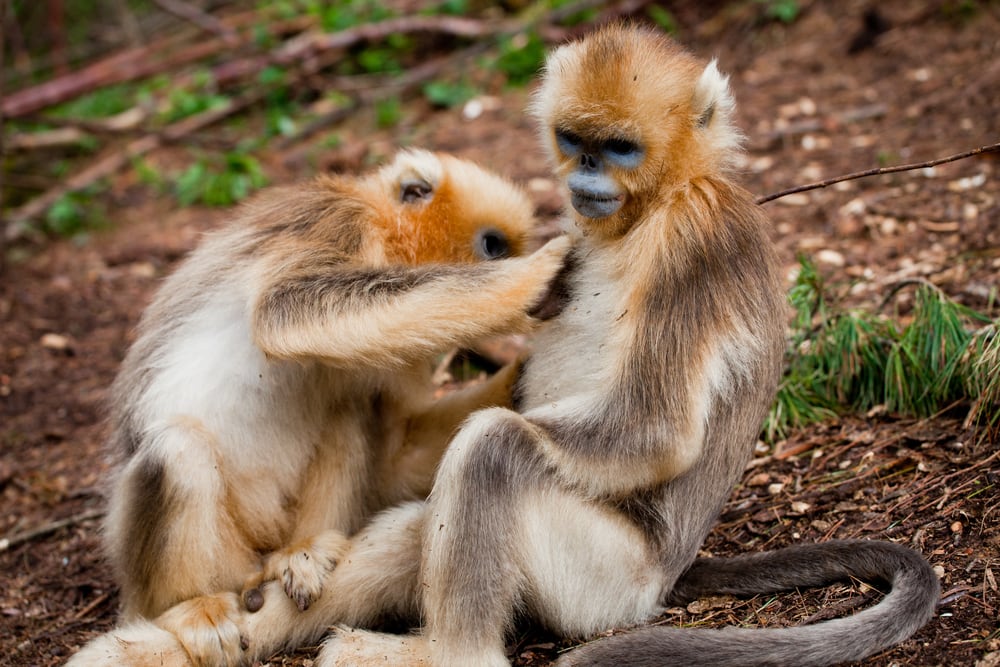
Golden snub-nosed monkeys practice fission-fusion. This is a social behavior in which the monkeys generally live in a larger group. They are social animals that feel safer when living in large numbers.
They do not remain in these large groups forever, though. They will break off into smaller groups, only to rejoin as a larger group later on.
Researchers can’t agree on what exactly triggers these monkeys to form larger groups. Seasonal changes, snow patterns, availability of food, and disturbances likely play a part.
Researchers who have observed this behavior also can’t quite agree on how they form these groups. Some researchers say that golden snub-nosed monkeys form three-tiered groups.
3-Tiered Systems
These monkeys live in smaller groups over the winter months. These groups consist of about 20-30 individuals. During the summer months, the smaller groups will combine into larger groups.
These groups often consist of about 200 individuals. Sometimes, these larger groups will come together to form even larger groups. Groups may have up to 600 individuals in total.
2-Tiered Systems
Other researchers insist that the monkeys only live in two-tiered systems. This means they form smaller groups that later form one larger group.
Polygamous Group Structures
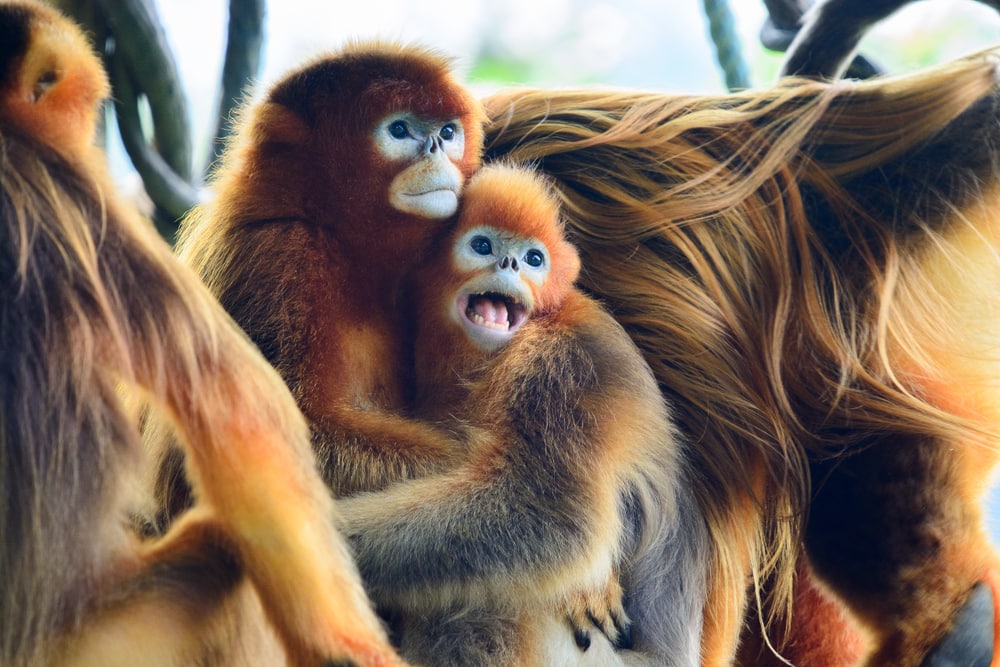
The monkeys may come together to form larger groups. But, they maintain their small polygamous group structure. A dominant male leads each small group. Within that group, there are usually about four females and their offspring.
Occasionally, all-male groups may form as well. These usually consist of bachelor males who have yet to head a group of females.
Communication
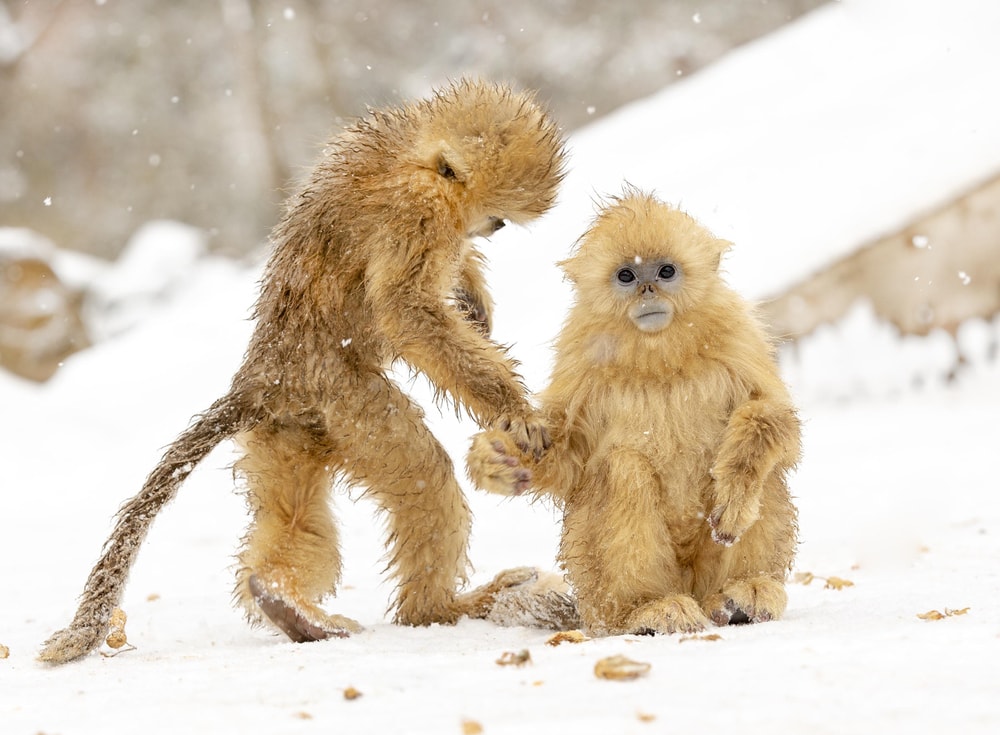
Those who observe this vocal species often compare them to a skilled ventriloquist. After all, golden snub-nosed monkeys are very vocal. They can even communicate without moving their body or their face.
So far, researchers have recorded 18 different vocalization patterns.
Although not necessary for vocalization, golden snub-nosed monkeys will take up physical stances. Opening and closing their mouth is common, as well as staring.
When eating, both males and females will emit a shrill whine. Males will also emit long whines while grooming, interspersed with shorter vocalizations.
In contrast, females produce an “ee-tcha” sound. They will often vocalize as groups. They may produce a loud chorus of whines, shrills, chatterings, or moans.
Mating & Reproduction
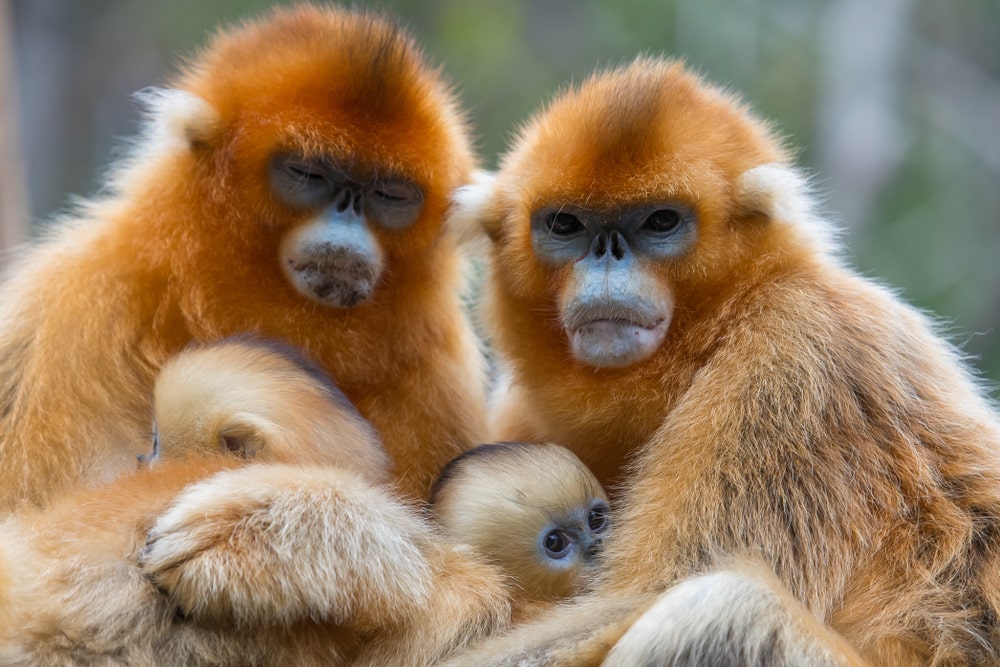
To tell whether a male golden snub-nosed monkey is old enough to mate, you simply need to look at his mouth. At sexual maturity, a male will develop large warty growths around their mouth. These growths are not present in females or males of other subspecies.
Researchers are unsure what these growths are for. One theory suggests that they may secrete a substance used in communication.
Sexually mature males are also easily spotted due to their brightly colored genitals. Their scrotum is a vibrant whitish-blue color, while the penis is a deep black.
Golden snub-nosed monkeys live in polygynous groups. This means the dominant male can mate with every female in his group. But unlike many species, the female decides when she’s ready to mate.
If she wants to play hard to get, she will make eye contact with the male and then run away.
But, she may also be more assertive about her desire. She may lay in the trees with her head hanging down. She will then keep her arms stretched out with her legs curled upwards. Her tail will be hanging down along with her head. Often, she’ll angle her genitals so that they’re facing the male.
Females must work to attract males several times throughout the day. The males only show interest about half the time. Successful mating occurs even less than that.
If a female becomes pregnant, the gestation period lasts about seven months. They give birth to a single offspring and provide all their care for them. The male will not help with any care other than occasional grooming.
You May Also Like: Apex Predator List: The Top 12 Predators At The Top Of The Food Chain
Growth & Lifespan
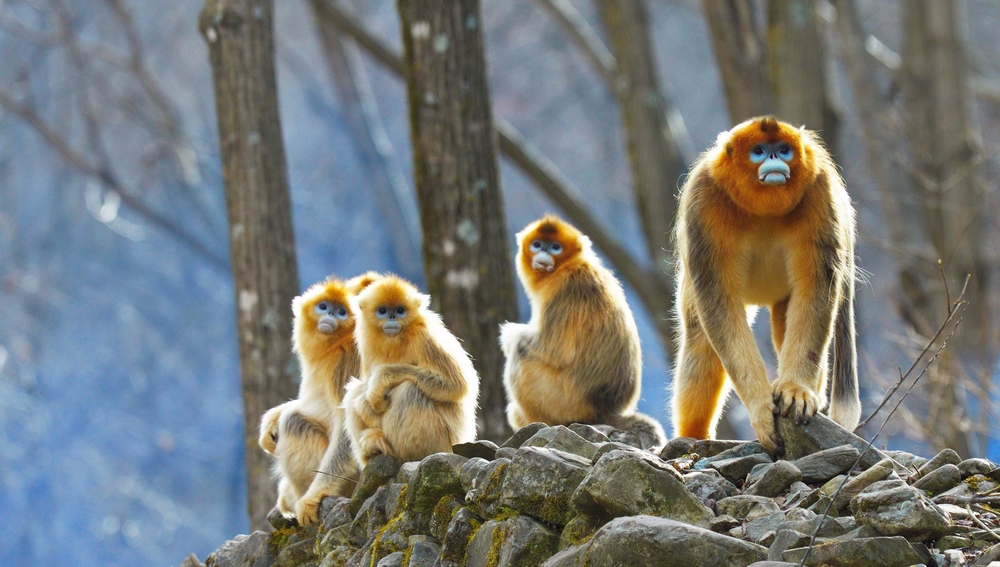
Once born, the baby will stay with the mother and nurse for about three weeks. Weaning occurs at about one year of age. Females will remain in their family group for their entire life.
Males leave their family group by the age of three. They will often form all-male groups until they’re old enough to form their own polygynous group.
Sexual maturity doesn’t occur in females until about four to five years of age. Males take even longer, not reaching sexual maturity until about seven years of age.
You can easily tell the males and females apart due to their size differences. Males will reach a weight of about 44lbs (19.9kg) and a length of about 26.8in (68.0cm). The females are much smaller, only reaching a weight of about 27lbs (12.2kg) and a length of about 20.4in (51.8cm).
Ever wondered how this species compares to the smallest monkeys in the world? You can read Outforia’s article to find out.
Their lifespans do not differ much for those living in the wild versus those in captivity. In the wild, golden snub-nosed monkeys average about 20-25 years. In captivity, they can live past 23 years of age.
You may also like: How Long Do Monkeys Live? From Old World To New World
Golden Snub-Nosed Monkey Facts
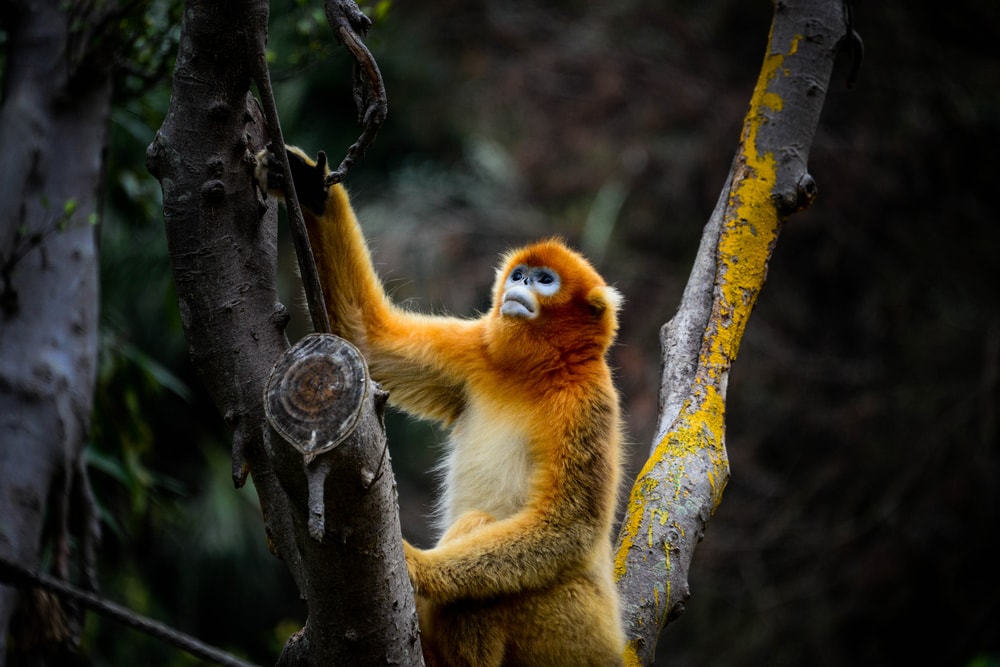
Endangered Primates
Unfortunately, golden snub-nosed monkeys are “endangered”. The International Union for the Conservation of Nature (IUCN) Red List lists them as endangered due to harmful human activity. We have lost over 50% of their population in the past 40 years due to deforestation alone.
They are quickly losing their habitat due to deforestation and development. Locals hunt these monkeys illegally for their meat, fur, and use in medicine. Plus, tourists disturb them in their natural habitat.
Golden snub-nosed monkeys don’t receive as much protection as they need. The main protection they receive is due to the giant pandas who share their habitat.
Giant pandas are a well-loved species amongst the public. They receive protection through conservation efforts.
But, they are also protected under China’s Wildlife Protection Act of 1989. They are also safe within several wildlife preserves. These preserves include:
- Baihe Nature Reserve
- Foping Nature Reserve
- Shennongjia Nature Reserve
- Wanglang Nature Reserve
The golden snub-nosed monkey is one of 25 primates listed as “endangered”. Check out this article to learn more about other species of monkeys.
The total population number of snub-nosed monkeys equals about 15,000 individuals. Their populations continue to decline, but at a slower rate than before.
Distributing Plants
Golden snub-nosed monkeys love to eat seeds. So, they’re responsible for transporting seeds throughout the jungle. These seeds spread through their feces, which are left to grow as they move around.
FAQ
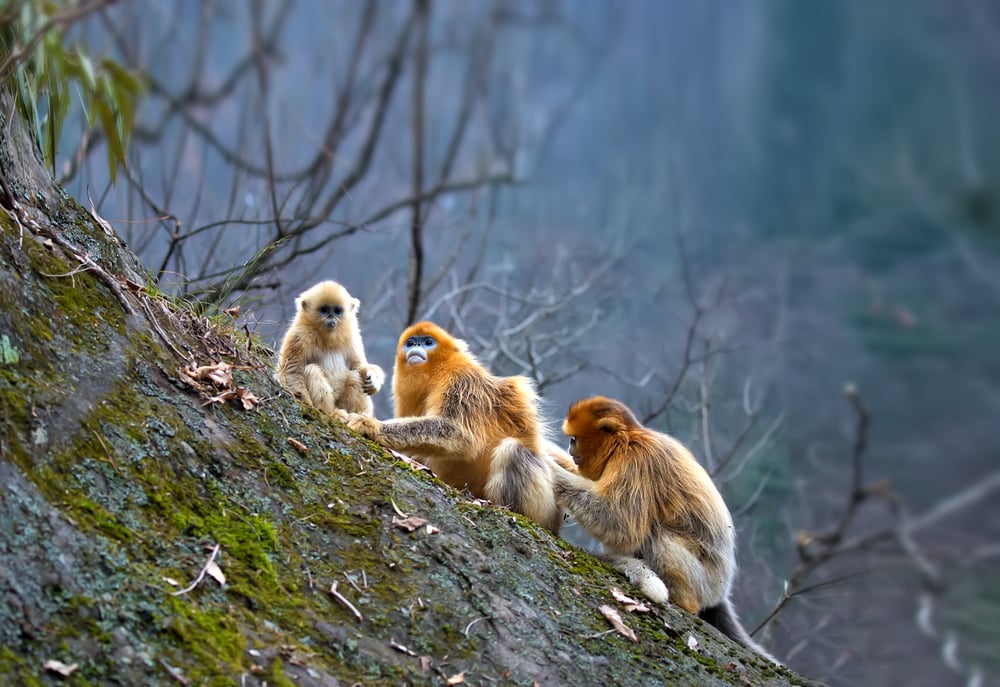
What adaptations do golden snub-nosed monkeys have?
Golden snub-nosed monkeys live in montane forests. The temperatures grow very cold over the winter months. They can withstand these cold temperatures, though.
The monkeys have large, stubby noses with nasal flaps. Researchers believe these nasal flaps can prevent frostbite.
They also have long, thick fur that keeps them warm over winter.
How do snub-nosed monkeys protect themselves?
Snub-nosed monkeys are smaller primates which leaves them susceptible to danger. The main form of protection they use is living in trees. As an arboreal species, they spend over 97% of their time in treetop canopies.
They also form large groups that offer extra protection. The dominant males will stay at the front and back of the group. This is to protect the smaller females and juveniles when traveling.
What is the difference between golden snub-nosed monkeys and golden monkeys?
The golden monkey (Cercopithecus kandti) is an Old World guenon. They are often confused with the golden snub-nosed monkey.
The golden monkey is not endemic to China. Instead, it’s found in Central and East Africa. They are native to the Virunga mountains. They live across Uganda, Rwanda, and the Democratic Republic of the Congo.
Their fur is similar in color. They have a golden-reddish hue with brownish-black on the back of the head and arms. But, there is no blue around the rim of their eyes, and their nose is much smaller.
What is an Old World monkey?
Old World monkeys belong to the superfamily Cercopithecoidea. Unlike apes, they have tails. But, unlike New World monkeys, their tails are not prehensile. This means that they cannot use their tails to climb or move around.
There are 78 species of Old World monkeys. This includes both the golden monkey and the golden snub-nosed monkey.



